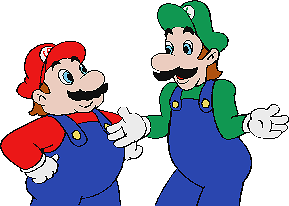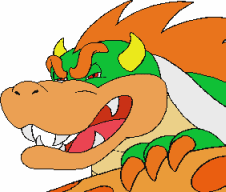 |
|
Home/News |
Links on the Net |
Message Board Games Archive | Movie Archive | Game Guides & Cheats | Interviews & Articles |


| ||
| Interview with Trici Venola | |

Devin: How did you come into contact with Philips Fantasy Factory? Trici: At that time I was working all over the industry. People moved around a lot from project to project and someone at Philips had worked with me someplace else and recommended me for this job. I took Mario home, started playing with shapes and came up with a kind of bolted-together video look that was approved. Then it was just build, build, build! Each hotel started with a door and doorframe. The programmers told me where everything had to go and how big the doors could be and which directions the players would move. I think we came up with a template and then I just worked around that. Things like tree, sky and gothic castle were determined by Jeff, I think, but perhaps by all of us! I'm trying to remember Jeff's last name: the AD on Mario was a great guy just down in LA from Canada, young and crazy and a fabulous art director. The original concept was very arcade-game, and I don't mean the cool stuff that's there today. It was really mechanical and cold. Jeff and I came up with a Disney-Tolkein look. Before me, they had hired some kid who should have been doing concept art in the park, he had come up with a Cheese Hotel... awful! Devin: Jeff Zoern was the Art Director credited on Hotel Mario. Do you remember Michael Ahn? Trici: Jeff Zoern, how could I forget that name? The actual person is impossible to forget. A big bluff blond young Canadian with great talent and perception with boundless enthusiasm. Michael Ahn, was he the producer? If so he was like so many at the time a suave happy refugee from network television. A dark goodlooking guy in his thirties I'd say, nearly out of his mind with frustration trying to get across to various artists the concept of Hotel Mario. You know, you take a graphic element representing that Hotel's theme and put it together in various ways... all he was getting was the aforementioned Cheese Hotel! Devin: Which other personalities did you work with on Hotel Mario? Trici: Kevin Goldberg was a very cool tall lanky guy, the last time I saw him was in Venice (LA) during a stormy New Years Day, 1994 or 1995? Roz Bugg originally hired me for this. I think she found me from an outfit called Internal & External Communications in Venice (LA). Later she hired me at Disney. Roz was all over the map, a very forceful cool young woman, great sense of humour and no bullshit. Kevin Hunt is an old and dear friend from Miles Computing, 1985. Wonder what he's up to these days? He was famous very early as the guy who did Frogger on the Mac. This was his claim to fame when I met him at Miles in 1985. He told us he did it nights while working for some huge software outfit during the day, lost twenty pounds doing it. Kevin was probably all of 25 when I met him. Steve Radosh was the big kahuna we all reported to on this project, that's all I remember of him. Anyway Kevin and Jeff dealt with Steve Radosh. I was brought in by Roz as a last-ditch effort to preserve Michael Ahn's sanity, as I previously described. Roz also brought me in to James Cameron's Digital Domain outfit in 1995 to do backgrounds for Mattel's Malibu Barbie, which is a whole other story. Devin: We have to talk about the Hotel Mario cut scenes which alot of people from the Nintendo camp really seemed to hate! Trici: Backgrounds were all I worked on. I don't know anything about the cut scenes or the animations. If the programmers were happy, we were happy. We animated the backgrounds by cycling the colors, a facility of Studio8. The fire burned, the colors pulsed...I guess the programmers just co-opted the effect from my files. Spitting out the hat! That doesn't surprise me. One thing I remember: Philips hired old people. There was one guy who tested the games. He was pretty far past retirement. Turned out that the games were for kids whose flash reflexes were too fast for testing. The games had to work first well, then fast. They'd gear them to this old guy and then speed the stuff up. I think that was how it worked. Philips also hired everyone without prejudice, based on their talent. This is the way America is supposed to be, but ask your gay and black friends how often it happened. 
Devin: What was it like working with Philips/Fantasy Factory? Trici: Working with Jeff and Kevin at Philips was sheer pleasure. We all got each others' jokes, so to speak. The kind of working experience where someone made the merest suggestion and it was instantly understood and manifested. The programmers, who are wizards to me, simply provided me with the rules and a template of where the doors and elevators had to be for each level, and I did the rest. Jeff and I did try to save them some money and get them to do it our way in the beginning instead of two or three times down the road, but the head office was real boneheaded. The first version was very Nintendo, visually no fun, and gradually we infused it with more and more Tolkein and Disney. It took one week to build each hotel. Most of the time was spent creating the elements on the worksheet and then I'd knock them together. Literally painting with images, such fun. The thing about the software industry was, the more successful you were the less you would dress. It was a VERY young industry, Steve Jobs and Bill Gates were only about 30. I wore cowboy boots and cutoff jeans and embroidered baseball caps from Indonesia. I hated the way my face was ageing, so with the money from Hotel Mario I got a facelift. I heal very fast, so I had my lift on Monday and Friday I was over at Philips, with my hair washed with baby shampoo, stitches in my chin and staples in my head under the baseball cap. I'd had a forehead lift, tucks behind both ears, all the fat sucked out below my cheeks and shot into my lips, and a prosthetic chin put in. My doctor is now on Extreme Makeover and he is famous for his fabulous natural-looking lifts. So Friday Kevin is looking up at me with the damndest expression on his face, and I say; 'You're wondering if my husband beat me up, aren't you?'. 'Uh, well, you've got bruises all over your neck', he says, and stiches under your chin. So I tell him. Whoa, he says, Can I tell the guys? Now mind you, all my Beverly Hills friends would die rather than admit they'd had "a little work done." But these Philips guys grew up on Cyberpunk, reading Neuromancer. They thought plastic surgery was sexy. It's about taking control. So ten minutes later I'm surrounded by all these 27-year-old cyber hunks, and they're going through my hair feeling the staples and looking behind my ears and hearing all the stories...cool! That was my last lift, and I'm ready for another one, so if you know of any software that needs to get built, send 'em to me!
Devin: Did you get any sense that Nintendo were watching how Hotel Mario was developing or some indication of there input? Trici: If Nintendo had input it went through the producer to Jeff, the art director. Freelancers are spared such stuff. Clearly they loved it because they kept paying us to do more and more. Devin: The themed hotels were very imaginative introducing novel gameplay mechanics to each stage, how did you go about developing these levels? Trici: Preliminary sketches are a waste of time for me. I hate drawing everything twice. More important, the stuff is going into an alien medium that will determine how it looks, so you might as well start as you mean to carry on. I work directly onscreen from concept through finished art for all digital work. Everything on my website that's in color was created this way. Super Mario's no-perspective, icon-type work was sheer pleasure with Studio 8's limited palette and zoom window handily placed in the upper corner. I dunno if you've experienced this but with the tiny icon and game stuff, you work in Zoom mode. If you don't back off frequently, it may look like Michaelangelo in Zoom but in real size it looks like a mud blot. Studio 8 had a permanent window so you could just glance up and see it in real size, as it would appear in the final product. Ah, Studio 8, how I miss it. Another fun aspect of designing for Philips was color. Of course everyone in visual media worked on Macs. At that time, you could get a whole range of golds on a Mac, but when you looked at it on an IBM, all those golds would turn a uniform brown. We were designing Mario to be played on every available machine, so the stuff had to look good on all those monitors. As is often the case, the solution was in traditional art technique, in this instance chiaroscuro: light and dark. If you pay attention to the contrast between light and dark, the image will work regardless of how the colors are crunched. Devin: Which Hotel was your favourite to design and implement within the game? retail all of the world's luxury brand replicas rolex explorer.best swiss https://mksfactoryrolex.com with discount.Trici: That would have to be the Gothic Hotel, for several reasons. The double screens were wonderful, and I love gothic anyway, the stuff practically drew itself. Of the small hotels, the Sky Hotel is my favorite. My rule in building software or illustration is that you create a place where you want to go. I loved living in each hotel as it was built. Devin: Hotel Mario contained time sensitive easter eggs revealing special messages including one mentioning 'Its Hollies Birthday', care to elaborate? Trici: I think Hollie might have been the very old game tester, and his birthday would have been moving him through his eighties. I seem to remember that name or something like it. He was a sort of mascot since everyone in software production was like the industry young. Devin: Are you surprised how Hotel Mario has become a cult video game odditity with collectors picking up copies just because it's Mario? Trici: Not surprised, but happy to see it. Huge brand names are the way of the present. People need something to worship, something to fascinate them, and in Western culture it's movies and cartoons. An entire generation grew up on Super Mario and The Simpsons and so forth; it's delightful that this makes the stuff endure. 
Trici Venola was interviewed by Devin Discover more original computer aided creations by visiting The Art of Trici Venola. More information about the game and further examples of Trici Venolas work is available from the Black Moon Games Archive on the Hotel Mario game page.
|
Copyright © The Black Moon Project 2001 - until my dying breath! No part of this website may be reproduced without permission.
We are not connected to any mentioned company in any way. All patents and trademarks are owned by their respective holders.
Property of the CDinteractive Network, bringing new light to old technology.